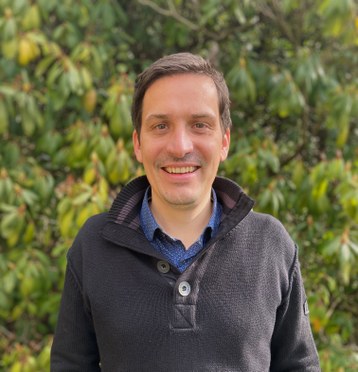Prof. Dr. Peter Biedermann
|
Kontakt:Email: peter.biedermann[at]forento.uni-freiburg.de Telefon: +49 761/203 54111 OCID ID: 0000-0003-4234-5659 Sopus ID: 24334393600 Sprechstunde: Dienstags 8:30 Uhr - 12:00 Uhr, Terminbuchung hier |
Leiter der ProfessurPeter ist ein passionierter organismischer Biologe und forscht an der Evolution von Sozialverhalten und zwischenartlichem Mutualismus. Über die Projekte seiner Arbeitsgruppe hinaus beschäftigt er sich mit den ökologischen Faktoren, die Insekt-Pilz-Mutualismen selektieren, und mit evolutionärer Landwirtschaft. Zum Beispiel versucht er herauszufinden, ob Menschen von Pilze züchtenden Insekten lernen können, um eine nachhaltigere Landwirtschaft aufzubauen. Sein Hauptmodellorganismus sind Borken- und Ambrosiakäfer.
|
Ausgewählte PublikationenSchebeck M, Schopf A, Ragland GJ, Stauffer C, and Biedermann PHW. 2022. ‘Evolutionary ecology of the bark beetles Ips typographus and Pityogenes chalcographus’. Bulletin of Entomological Research. doi: 10.1017/S0007485321000353. Diehl JMC, Kowallik V, Keller A, and Biedermann PHW. 2022. ‘First experimental evidence for active farming in ambrosia beetles and strong heredity of garden microbiomes’. bioRxiv. doi: 10.1101/2022.07.27.501732 Mayers CG, Harrington T, and Biedermann PHW. 2022. ‘Mycangia Define the Diverse Ambrosia Beetle-Fungus Symbioses’. Pp. 105–42 in The convergent evolution of agriculture in humans and insects. Lehenberger M, Foh N, Göttlein A, Six D, and Biedermann PHW. 2021. ‘Nutrient-Poor Breeding Substrates of Ambrosia Beetles Are Enriched With Biologically Important Elements’. Frontiers in Microbiology 12:927. doi: 10.3389/fmicb.2021.664542. Ibarra-Juarez LA., Burton MAJ, Biedermann PHW, Cruz L, Desgarennes D, Ibarra-Laclette E, Latorre A, Alonso-Sánchez A, Villafan E, Hanako-Rosas G, López L, Vázquez-Rosas-Landa M, Carrion G, Carrillo D, Moya A, and Lamelas A. 2020. ‘Evidence for Succession and Putative Metabolic Roles of Fungi and Bacteria in the Farming Mutualism of the Ambrosia Beetle Xyleborus Affinis’. MSystems 5(5):e00541-20. doi: 10.1128/mSystems.00541-20. Biedermann PHW., and Vega FE. 2020. ‘Ecology and Evolution of Insect–Fungus Mutualisms’. Annual Review of Entomology 65(1):431–55. doi: 10.1146/annurev-ento-011019-024910. Biedermann PHW, Müller J, Grégoire J, Gruppe A, Hagge J, Hammerbacher A, Hofstetter RW, Kandasamy D, Kolarik M, Kostovcik M, Krokene P, Sallé A, Six D, Turrini T, Vanderpool D, Wingfield MJ, and Bässler C. 2019. ‘Bark Beetle Population Dynamics in the Anthropocene: Challenges and Solutions’. Trends in Ecology & Evolution 34(10):914–24. doi: 10.1016/j.tree.2019.06.002. Ranger CM, Biedermann PHW (shared first authorship), Phuntumart V, Beligala GU, Ghosh S, Palmquist DE, Mueller R, Barnett J, Schultz PB, Reding ME, and Benz JP. 2018. ‘Symbiont Selection via Alcohol Benefits Fungus Farming by Ambrosia Beetles’. Proceedings of the National Academy of Sciences115(17):4447–52. doi: 10.1073/pnas.1716852115. Birkemoe T, Jacobsen RM, Sverdrup-Thygeson A, and Biedermann PHW. 2018. ‘Insect-Fungus Interactions in Dead Wood Systems’. Pp. 377–427 in Saproxylic Insects: Diversity, Ecology and Conservation, Zoological Monographs, edited by M. D. Ulyshen. Heidelberg: Springer International Publishing. Biedermann PHW and Rohlfs M. 2017. ‘Evolutionary Feedbacks between Insect Sociality and Microbial Management’. Current Opinion in Insect Science 22:92–100. doi: 10.1016/j.cois.2017.06.003. Kirkendall LR, Biedermann PHW, and Jordal BH. 2015. ‘Evolution and Diversity of Bark and Ambrosia Beetles’. Pp. 85–156 in Bark Beetles, edited by F. E. Vega and R. W. Hofstetter. San Diego: Academic Press. (book chapter) Biedermann PHW, and Taborsky M. 2011. ‘Larval Helpers and Age Polyethism in Ambrosia Beetles’. Proceedings of the National Academy of Sciences 108(41):17064–69. doi: 10.1073/pnas.1107758108. Biedermann PHW, Klepzig KD, and Taborsky M. 2009. ‘Fungus Cultivation by Ambrosia Beetles: Behavior and Laboratory Breeding Success in Three Xyleborine Species’. Environmental Entomology38(4):1096–1105. doi: 10.1603/022.038.0417 |


